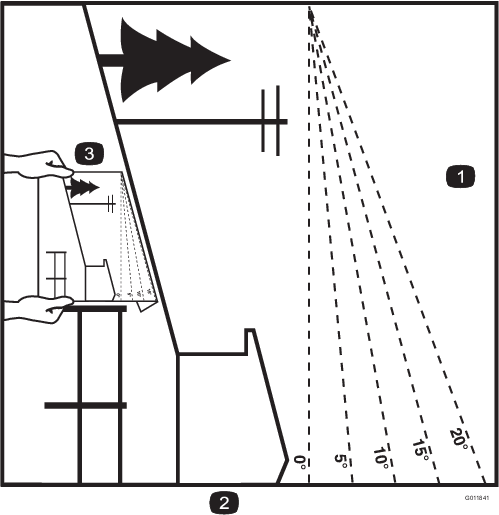| Maintenance Service Interval | Maintenance Procedure |
|---|---|
| Before each use or daily |
|
Introduction
CONGRATULATIONS on the purchase of your Exmark Mower. This product has been carefully designed and manufactured to give you a maximum amount of dependability and years of trouble-free operation.
This manual contains operating, maintenance, adjustment, and safety instructions for your Exmark mower.
BEFORE OPERATING YOUR MOWER, CAREFULLY READ THIS MANUAL IN ITS ENTIRETY.
By following the operating, maintenance, and safety instructions, you will prolong the life of your mower, maintain its maximum efficiency, and promote safe operation.
To maximize safety, performance, and proper operation of this machine, it is essential that all operators carefully read and fully understand the contents of the Operator’s manual provided with the product. Failure to comply with the operating instructions or receive proper training may result in injury. Go to https://www.Exmark.com for additional safe operation information, such as safety tips, training materials, and Operator’s manuals.
If additional information is needed, or should you require trained mechanic service, contact your authorized Exmark equipment dealer or distributor.
All Exmark equipment dealers and distributors are kept informed of the latest methods of servicing and are equipped to provide prompt and efficient service in the field or at their service stations. They carry ample stock of service parts or can secure them promptly for you from the factory.
All Exmark parts are thoroughly tested and inspected before leaving the factory, however, attention is required on your part if you are to obtain the fullest measure of satisfaction and performance.
Whenever you need service, genuine Exmark parts, or additional information, contact an Authorized Service Dealer or Exmark Customer Service and have the model and serial numbers of your product ready.
Figure 1 identifies the location of the model and serial numbers on the product. Write the numbers in the space provided.
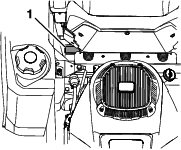
For complete warranty details, see https://www.Exmark.com. You may also call us 402-223-6375 to request a written copy of the product’s warranty.
Warning
CALIFORNIA
Proposition 65 Warning
The engine exhaust from this product contains chemicals known to the State of California to cause cancer, birth defects, or other reproductive harm.
Battery posts, terminals, and related accessories contain lead and lead compounds, chemicals known to the State of California to cause cancer and reproductive harm. Wash hands after handling.
Use of this product may cause exposure to chemicals known to the State of California to cause cancer, birth defects, or other reproductive harm.
Important: It is a violation of California Public Resource Code Section 4442 or 4443 to use or operate the engine on any forest-covered, brush-covered, or grass-covered land unless the engine is equipped with a spark arrester, as defined in Section 4442, maintained in effective working order or the engine is constructed, equipped, and maintained for the prevention of fire.
To acquire a spark arrester for your unit, see your Engine Service Dealer.
For all models that do not have Exmark engines, please refer to the engine manufacturer's information included with the machine.
For models with Exmark engines, refer to this manual for information.
The gross or net horsepower (or torque) of this engine was laboratory rated by the engine manufacturer in accordance with the Society of Automotive Engineers (SAE) J1940 or J2723. As configured to meet safety, emission, and operating requirements, the actual engine horsepower (or torque) on this class of mower will be significantly lower.

Safety
This machine has been designed in conformance with the American National Standards Institute B71.1 for Consumer Turf Care Equipment–Safety Specifications.
Safety Alert Symbol
This Safety Alert Symbol (Figure 2) is used both in this manual and on the machine to identify important safety messages which must be followed to avoid accidents.
This symbol means: ATTENTION! BECOME ALERT! YOUR SAFETY IS INVOLVED!

The safety alert symbol appears above information which alerts you to unsafe actions or situations and will be followed by the word DANGER, WARNING, or CAUTION.
DANGER: Indicates an imminently hazardous situation which, if not avoided, Will result in death or serious injury.
WARNING: Indicates a potentially hazardous situation which, if not avoided, Could result in death or serious injury.
CAUTION: Indicates a potentially hazardous situation which, if not avoided, May result in minor or moderate injury.
This manual uses two other words to highlight information. Important calls attention to special mechanical information and Note emphasizes general information worthy of special attention.
General Safety
This machine is capable of amputating hands and feet and of throwing objects. Always follow all safety instructions to avoid serious personal injury or death.
-
Read, understand, and follow all instructions and warnings in the Operator’s Manual and on the machine, engine, and attachments. All operators and mechanics should be trained. If the operator(s) or mechanic(s) can not read this manual, it is the owner’s responsibility to explain this material to them; other languages may be available on our website.
-
Only allow trained, responsible, and physically capable operators that are familiar with the safe operation, operator controls, and safety signs and instructions to operate the machine. Never let children or untrained people operate or service the equipment. Local regulations may restrict the age of the operator.
-
Do Not operate the machine near drop-offs, ditches, embankments, water, or other hazards, or on slopes greater than 15 degrees.
-
Keep bystanders and children out of the operating area.
-
Do Not put your hands or feet near moving parts.
-
Do Not operate the machine without all safety shields, guards, switches, and other devices in place and in proper working condition.
-
Park machine on level ground, move the motion control levers out to engage the parking brake, disengage the blade control switch, stop engine, and remove key and wait for all moving parts to stop before leaving the operating position. Allow the machine to cool before servicing, adjusting, fueling, cleaning, or storing.
Safety and Instructional Decals
 |
Safety decals and instructions are easily visible to the operator and are located near any area of potential danger. Replace any decal that is damaged or lost. |

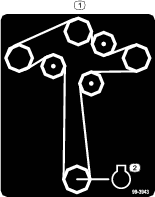

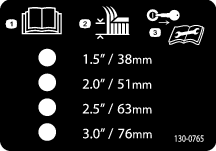
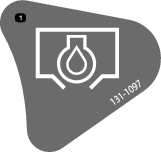
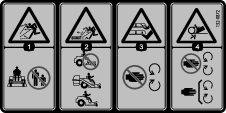





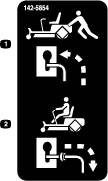
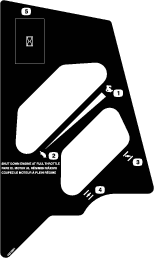
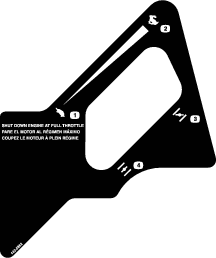




Specifications
Systems
Engine
-
Engine Specifications: See your Engine Owner’s Manual
-
Engine Oil Type: Exmark 4-Cycle Premium Engine Oil
-
RPM: Full Speed: 3300 ±100 (max) RPM (No Load)Idle: 1650 (min) RPM
Fuel System
-
Capacity: 3.0 gal. (11 L)
-
Fuel Recommendations:
-
For best results, use only clean, fresh, unleaded gasoline with an octane rating of 87 or higher ((R+M)/2 rating method).
-
Oxygenated fuel with up to 10% ethanol or 15% MTBE by volume is acceptable.
-
Do Not use ethanol blends of gasoline (such as E15 or E85) with more than 10% ethanol by volume. Performance problems and/or engine damage may result which may not be covered under warranty.
-
Do Not use gasoline containing methanol.
-
Do Not store fuel either in the fuel tank or fuel containers over the winter unless a fuel stabilizer is used.
-
Do Not add oil to gasoline.
-
-
Fuel Filter: In-line
Electrical System
-
Charging System: Flywheel Alternator
-
Charging Capacity: 15 amps
-
Battery Type: 230 CCA
-
Battery Voltage: 12 Volt
-
Polarity: Negative Ground
-
Fuses: One 25 amp, one 15 amp; blade type
Safety Interlock System
-
PTO must be disengaged and motion control levers moved to the outward position to engage the parking brake to start engine. (It is not necessary for the operator to be in the seat to start the engine.)
-
Operator must be in seat when PTO is engaged or engine will stop.
Operator Controls
-
Steering and Motion Control:
Note: Motion control levers are adjustable to two heights.
-
Separate levers, on each side of the console, control speed and direction of travel of the respective drive wheels.
-
Steering is controlled by varying the position of the levers relative to each other.
-
Moving motion control levers outward (in slots) locks the drive system in neutral.
-
-
PTO Engagement Switch: Engages electric clutch (to drive belt) which engages mower blades.
-
Parking Brake Lever: Engages/Disengages parking brake.
-
Deck Height Adjustment Lever: Sets cutting height to desired position.
-
Deck Lift Assist Lever: Foot pedal that assists in raising the deck.
Seat
-
Type:
-
E-Series models: Two tone upholstered high back, foam padded with spring suspension.
-
S-Series models: Two tone upholstered high back, foam padded seat with spring suspension.
-
-
Mounting: Hinged to tilt up for access to battery and other components. Adjustable fore and aft.
-
Armrests (S-Series Only): Standard–molded flip-up armrests.
-
Seat Safety Switch: Incorporated into the Safety Interlock System.
Hydrostatic Ground Drive System
-
Hydrostatic Pumps:
-
34, 42, and 50 inch E-Series model: Two Hydro Gear ZT2100 Integrated drive systems.
-
54 inch S-Series model: Two Hydro Gear ZT2200 Integrated drive systems.
-
-
Hydraulic Oil Type: Exmark Premium Hydro Oil.
-
Speeds:
-
0-7.0 mph (11.3 km/hr) forward.
-
0-5.0 mph (8.0 km/hr) reverse.
-
-
Drive wheel releases, located on left and right sides of engine deck, allow machine to be moved when the engine is not running and brake is off.
Tires and Wheels
| Drive | ||
|---|---|---|
| Pneumatic (Air-Filled) | ||
| Deck Size | 34 | 42 |
| Quantity | 2 | 2 |
| Tread | K500 | K500 |
| Size | 18 x 6.00-8 | 18 x 7.50-8 |
| Ply Rating | 4 | 4 |
| Pressure | 13 psi (90 kPa) | 13 psi (90 kPa) |
| Drive | ||
|---|---|---|
| Pneumatic (Air-Filled) | ||
| Deck Size | 50 | 54 |
| Quantity | 2 | 2 |
| Tread | K500 | K500 |
| Size | 18 x 9.5-8 | 20 x 10-10 |
| Ply Rating | 4 | 4 |
| Pressure | 13 psi (90 kPa) | 13 psi (90 kPa) |
| Front Caster | ||
|---|---|---|
| Pneumatic (Air-Filled) | ||
| Deck Size | 34 and 42 | 50 and 60 |
| Quantity | 2 | 2 |
| Tread | Smooth | Smooth |
| Size | 11 x 4-5 | 13 x 6.5-6 |
| Ply Rating | 2 | 4 |
| Pressure | 13 psi (90 kPa) | 13 psi (90 kPa) |
Cutting Deck
-
Cutting Width:
-
34 inch Deck: 34 inches (86 cm)
-
42 inch Deck: 42 inches (107 cm)
-
50 inch Deck: 50 inches (127 cm)
-
54 inch Deck: 54 inches (138 cm)
-
-
Discharge: Side
-
Blade Size:
-
34 inch Deck: 17.50 inches (44.5 cm)–Qty: 2
-
42 inch Deck: 21.60 inches (54.9 cm)–Qty: 2
-
50 inch Deck: 17.50 inches (44.5 cm)–Qty: 3
-
54 inch Deck: 18.75 inches (47.6 cm)–Qty: 3
-
-
Blade Spindles: Solid steel spindles with no maintenance bearings.
-
Deck Drive: Electric clutch mounted on vertical engine shaft. Blades are driven by one belt (w/self-tensioning idler) direct from the engine.
-
Deck: Full floating deck is attached to out-front support frame. Maximum turf protection is provided with anti-scalp rollers.
Deck design allows for bagging, mulching or side discharge.
-
Deck Depth:
-
34 inch Deck: 4.0 inches (10.2 cm)
-
42 inch Deck: 4.0 inches (10.2 cm)
-
50 inch Deck: 4.0 inches (10.2 cm)
-
54 inch Deck: 4.0 inches (10.2 cm)
-
-
Cutting Height Adjustment: Cutting height can be adjusted from 1 1/2 inch (3.8 cm) to 4 1/2 inches (11.4 cm) in 1/2 inch (1.3 cm) increments.
-
34 and 42 Inch Models: Hand deck lift lever only
-
54 Inch Model: Foot pedal only
-
50 Inch Model: Hand deck lift lever with foot pedal assist
-
-
Mulching Kit: Optional.
Dimensions
Overall Width:
| 34 inch Deck | 42 inch Deck | 50 inch Deck | |
|---|---|---|---|
| Without Deck | 35.6 inches(90 cm) | 40.4 inches(103 cm) | 43.1 inches(110 cm) |
| Deflector Up | 38.5 inches(98 cm) | 45.8 inches(116 cm) | 50.9 inches(130 cm) |
| Deflector Down | 46.0 inches(117 cm) | 53.8 inches(137 cm) | 61.7 inches(157 cm) |
| 54 inch Deck | |
|---|---|
| Without Deck | 47.2 inches(120 cm) |
| Deflector Up | 54.7 inches(139 cm) |
| Deflector Down | 65.2 inches(166 cm) |
Overall Length:
| 34 inch Deck | 42 inch Deck | 50 inch Deck | 54inch Deck |
|---|---|---|---|
| 75.0 inches (191 cm) | 75.0 inches (191 cm) | 75.0 inches (191 cm) | 76.0 inches (193 cm) |
Overall Height:
| 34, 42, and 50 inch Deck | 54 inch Deck |
|---|---|
| 45.6 inches (116 cm) | 46.6 inches (119 cm) |
Tread Width: (Center to Center of Tires, Widthwise)
| 34 inch Deck | 42 inch Deck | |
|---|---|---|
| Drive Wheels | 32.1 inches(82 cm) | 33.0 inches(84 cm) |
| Caster Wheels | 30.5 inches(78 cm) | 30.5 inches(78 cm) |
| 50 inch Deck | 54 inch Deck | |
|---|---|---|
| Drive Wheels | 34.8 inches(88 cm) | 36.9 inches(94 cm) |
| Caster Wheels | 30.5 inches(78 cm) | 35.8 inches(91 cm) |
Wheel Base: (Center of Caster Tire to Center of Drive Tire)
| 34, 42, and 50 inch Decks | 45.6 inches (116 cm) |
| 54 inch Deck | 45.4 inches (115 cm) |
Curb Weight:
| 34 inch Deck | 42 inch Deck | 50 inch Deck |
|---|---|---|
| 502 lb (228 kg) | 515 lb (233 kg) | 576 lb (261 kg) |
| 54 inch Deck |
|---|
| 616 lb (279 kg) |
Torque Requirements
| Bolt Location | Torque |
|---|---|
| Spindle Pulley Nut | 35-65 ft-lb (47-88 N-m) |
| Blade Mounting Bolt | 60-80 ft-lb (81-108 N-m) |
| Engine Mounting Bolts | 400-500 in-lb (45-56 N-m) |
| Wheel Lug Nuts | 70-90 ft-lb (95-122 N-m) |
| Clutch Mounting Bolt (secured with threadlocker) | 50-60 ft-lb (68-81 N-m) |
Product Overview
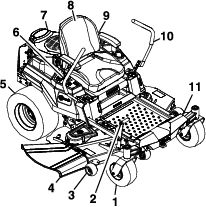
Operation
Note: Determine the left and right sides of the machine from the normal operating position.
Controls
Become familiar with all the controls before starting the engine and operating the machine.
Ignition Switch
Located on control panel.
The ignition switch is used to start and stop the engine. The switch has three positions “OFF”, “RUN” and “START” (Figure 4). Insert key into switch and rotate clockwise to the “ON” position. Rotate clockwise to the next position to engage the starter (key must be held against spring pressure in this position).

Note: Brake must be engaged and PTO switch “OFF” to start engine. (It is not necessary for the operator to be in the seat to start the engine.)
Turning the key to the “OFF” position will stop the engine; however, always remove the key when leaving the machine to prevent someone from accidentally starting the engine.
Blade Control Switch (Power Take-Off)
Located on control panel.
The blade control switch, represented by a power take-off (PTO) symbol, engages and disengages power to the mower blades (see Figure 4).
Pull up on the blade control switch to “ON” to engage the blades.
Push down on the blade control switch to “OFF” to disengage the blades.
Throttle Lever
Located on control panel.
The throttle is used to control engine speed. Moving throttle lever forward will increase engine speed and moving throttle lever to the rear will decrease engine speed. Moving the throttle forward until it stops is full throttle.
Choke Control
The choke is used to aid in starting a cold engine. Do Not run a warm engine with the choke in the “ON” position. Moving the choke lever forward will put the choke in the “ON” position and moving the choke lever to the rear will put the choke in the “OFF” position.
Motion Control Levers and Parking Brake Position
The motion control levers located on each side of the seat (Figure 5).
The motion control levers are speed sensitive controls of independent wheel motors. Moving a lever forward or backward turns the wheel on the same side forward or in reverse; wheel speed is proportional to the amount the lever is moved.
Moving the control levers outward from the center T-slot position engages the parking brake on the drive wheels. Always position the motion control levers into the parking brake position when you stop the machine or leave it unattended. The machine must be tied down and brake engaged when transporting.
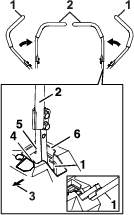
Deck Height Adjustment Hand Lever—For 34 and 42 Inch Models
Note: 50 inch models have both deck height adjustments: hand lever and foot assist pedal.
Located below the RH motion control lever.
Pull the lever inward and rearward to raise the cutting deck. Allow the handle to move forward to lower the cutting deck. Move the deck height adjustment lever outward at the desired height of cut. Only adjust the height of cut while the machine is not moving.
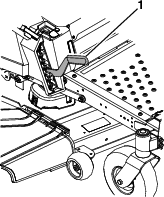
Deck Height Adjustment Foot Pedal—
Note: 50 inch models have both deck height adjustments: hand lever and foot assist pedal.
Locate at the right front corner of the floor pan (reference Figure 3).
The deck height adjustment foot pedal allows the operator to use their leg to assist in lowering and raising the deck from the seated position. Push the pedal forward with your foot to raise the cutting deck. Allow the pedal to move rearward to lower the cutting deck to the cut height that has been set.
Fuel Window
Located on the left side of the machine (see Figure 7).
The fuel window can be used to determine the amount of fuel in the tank.
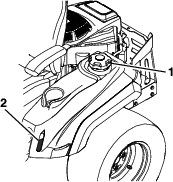
Hour Meter
Located on control panel.
The hour meter records the number of hours when the operator is in the seat and the ignition switch is in the “ON” position.
Before Operation
Before Operation Safety
-
Evaluate the terrain to determine what accessories and attachments are needed to properly and safely perform the job. Only use accessories and attachments approved by Exmark.
-
Inspect the area where the machine is to be used and remove all rocks, toys, sticks, wires, bones, and other foreign objects. These can be thrown or interfere with the operation of the machine and may cause personal injury to the operator or bystanders.
-
This mower was designed for one operator only. Do Not carry passengers.
-
Wear appropriate personal protective equipment such as safety glasses, long pants, substantial slip-resistant footwear, and hearing protection. Tie back long hair and avoid loose clothing and loose jewelry which may get tangled in moving parts.
-
This machine produces sound levels in excess of 85 dBA at the operator’s ear and can cause hearing loss through extended periods of exposure. Wear hearing protection when operating this machine.
-
Check that the following items are in place and in proper working condition: the operator presence controls, safety switches, guards, shields, discharge deflector and/or the entire grass catcher system. Do not operate the machine unless they are in proper working condition. Replace worn or deteriorated parts with genuine Exmark parts when necessary.
Danger
It is essential that operator safety mechanisms be connected and in proper operating condition prior to use. Contacting the blade can result in serious personal injury.
Shut off the engine, remove the key, and wait for all moving parts to stop before leaving the operating position. When the key is turned to the “OFF” position, the engine should shut off and the blade should stop. If not, stop using the machine immediately and contact an Authorized Service Dealer.
-
Do Not operate the mower when people, especially children, or pets are in the area. Shut off the machine and attachment(s) if anyone enters the area.
-
Do Not operate the machine without the entire grass collection system, discharge deflector, or other safety devices in place and in proper working condition. Grass catcher components are subject to wear, damage and deterioration, which could expose moving parts or allow objects to be thrown. Frequently check for worn or deteriorating components and replace them with the manufacturer’s recommended parts when necessary.
Fuel Safety
Danger
Gasoline is extremely flammable and vapors are explosive.
A fire or explosion from gasoline can burn you, others, and cause property damage.
-
Fill the fuel tank outdoors on level ground, in an open area, when the engine is cold. If fuel is spilled, Do Not attempt to start the engine. Move away from the area of the spill and avoid creating any source of ignition until fuel vapors have dissipated.
-
Do Not refill the fuel tank or drain the machine indoors or inside an enclosed trailer.
-
Never smoke when handling gasoline, and stay away from an open flame or where gasoline fumes may be ignited by spark.
-
Add fuel before starting the engine. Never remove the cap of the fuel tank or add fuel when engine is running or when the engine is hot.
-
Store gasoline in an approved container and keep it out of the reach of children.
-
Do Not operate without entire exhaust system in place and in proper working condition.
-
In certain conditions during fueling, static electricity can be released causing a spark which can ignite gasoline vapors.
-
Do Not fill containers inside a vehicle or on a truck or trailer bed with a plastic liner. Always place containers on the ground and away from your vehicle before filling.
-
When practical, remove gas-powered equipment from the truck or trailer and refuel the equipment with its wheels on the ground. If this is not possible, then refuel such equipment on a truck or trailer from a portable container, rather than from a gasoline dispenser nozzle.
-
If a gasoline dispenser nozzle is used, keep the nozzle in contact with the rim of the fuel tank or container opening at all times until fueling is complete. Do Not use a nozzle lock open device.
-
-
Do Not overfill the fuel tank. Fill the fuel tank to the bottom of the filler neck. The empty space in the tank allows gasoline to expand. Overfilling may result in fuel leakage or damage to the engine or emission system.
-
Gasoline is harmful or fatal if swallowed. Long-term exposure to vapors may cause serious injury and illness.
-
Avoid prolonged breathing of vapors.
-
Keep face away from nozzle and gas tank/container opening.
-
Keep away from eyes and skin.
-
-
To help prevent fires:
-
Keep engine and engine area free from accumulation of grass, leaves, excessive grease or oil, and other debris which can accumulate in these areas.
-
Clean up oil and fuel spills and remove fuel soaked debris.
-
Allow the machine to cool before storing the machine in any enclosure. Do Not store the machine or fuel container, or refuel, where there is an open flame, spark, or pilot light such as on a water heater or other appliance.
-
Filling the Fuel Tank
Use a fuel stabilizer/conditioner in the machine to provide the following benefits:
-
Keeps gasoline fresh during storage of 30 days or less. For longer storage it is recommended that the fuel tank be drained.
-
Cleans the engine while it runs.
-
Eliminates gum-like varnish buildup in the fuel system, which causes hard starting Add the correct amount of gas stabilizer/conditioner to the gas.
Note: A fuel stabilizer/conditioner is most effective when mixed with fresh gasoline. To minimize the chance of varnish deposits in the fuel system, use fuel stabilizer at all times.
Make sure the engine is shut off and the motion controls are moved outward to engage the parking brake. Tank maximum capacity is 3 gallons (11 L).
Note: Use the fuel window to verify the presence of gasoline before filling the tank.
Important: Do Not overfill fuel tank. Fill the fuel tank to the bottom of the filler neck. The empty space in the tank allows the fuel to expand. Overfilling may result in fuel leakage or damage to the engine or emission system.
-
Shut the engine off, move the motion controls outward to the neutral lock position, and engage parking brake.
-
Clean around the fuel tank cap and remove the cap.
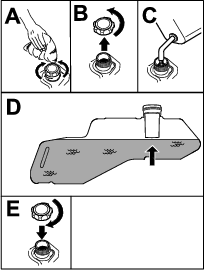
-
Add unleaded regular gasoline until the fuel reaches the base of the filler neck and does not fill the neck of the tank. This space at the base of the filler neck allows gasoline to expand. Do Not fill the fuel tank completely full. Overfilling may result in fuel leakage or damage to the engine or emissions system.
-
Install the fuel tank cap securely and tighten until it “clicks”. Wipe up any gasoline that may have spilled.
Operating Instructions
During Operation Safety
General Safety
The operator must use their full attention when operating the machine. Do Not engage in any activity that causes distractions; otherwise, injury or property damage may occur.
Warning
Operating engine parts, especially the muffler, become extremely hot. Severe burns can occur on contact and debris, such as leaves, grass, brush, etc. can catch fire.
Clean the machine as stated in the Maintenance section. Keep engine and engine area free from accumulation of grass, leaves, excessive grease or oil, and other debris which can accumulate in these areas.
-
Operate the engine only in well-ventilated areas. Exhaust gases contain carbon monoxide, which is an odorless deadly poison.
-
Do Not operate the machine while ill, tired, or under the influence of alcohol or drugs.
-
Operate the machine only in good visibility and appropriate weather conditions. Do Not operate the machine when there is the risk of lightning.
-
Keep away from holes, ruts, bumps, rocks, and other hidden hazards. Use care when approaching blind corners, shrubs, trees, tall grass or other objects that may hide obstacles or obscure vision. Uneven terrain could overturn the machine.
-
Start the engine with your feet well away from the blades.
-
Do Not operate the machine without all safety shields, guards, switches, and other devices in place and in proper working condition.
-
Keep your hands and feet away from the moving parts. Keep clear of the discharge opening.
-
Do Not mow with the discharge deflector raised, removed, or altered unless there is a grass-collection system or mulch kit in place and working properly.
-
Be aware of the mower discharge path and direct discharge away from others. Avoid discharging material against a wall or obstruction as the material may ricochet back toward the operator. Stop the blades, slow down, and use caution when crossing surfaces other than grass and when transporting the mower to and from the area to be mowed.
-
Be alert, slow down and use caution when making turns. Do Not mow in reverse unless it is absolutely necessary. Always look down and behind you before moving the machine in reverse.
-
Park the machine on level ground. Stop engine, wait for all moving parts to stop, and remove key.
-
Before checking, cleaning or working on the mower.
-
After striking a foreign object or abnormal vibration occurs (inspect the mower for damage and make repairs before restarting and operating the mower).
-
Before clearing blockages.
-
Whenever you leave the mower. Do Not leave a running machine unattended.
-
-
Stop engine, wait for all moving parts to stop:
-
Before refueling.
-
Before dumping the grass catcher.
-
Before making height adjustments.
-
-
Tragic accidents can occur if the operator is not alert to the presence of children. Children are often attracted to the machine and the mowing activity. Never assume that children will remain where you last saw them.
-
Keep children out of the mowing area and under the watchful care of another responsible adult, not the operator.
-
Be alert and turn the machine off if children enter the area.
-
Before and while backing or changing direction, look behind, down, and side-to-side for small children.
-
Never allow children to operate the machine.
-
Do Not carry children, even with the blades shut off. Children could fall off and be seriously injured or interfere with the safe operation of the machine. Children that have been given rides in the past could suddenly appear in the working area for another ride and be run over or backed over by the machine.
-
-
Do Not use the machine as a towing vehicle unless it has a hitch installed. Attach towed equipment to the machine only at the hitch point.
Slope Safety
-
Slopes are a major factor related to loss of control and rollover accidents, which can result in severe injury or death. The operator is responsible for safe slope operation. Operating the machine on any slope requires extra caution. Before using the machine on a slope, the operator must:
-
Review and understand the slope instructions in the manual and on the machine.
-
Use an angle indicator to determine the approximate slope angle of the area.
-
Never operate on slopes greater than 15 degrees.
-
Evaluate the site conditions of the day to determine if the slope is safe for machine operation. Use common sense and good judgment when performing this evaluation. Changes in the terrain, such as moisture, can quickly affect the operation of the machine on a slope.
-
-
Identify hazards at the base of the slope. Do Not operate the machine near drop offs, ditches, embankments, water or other hazards. The machine could suddenly roll over if a wheel goes over the edge or the edge collapses. Keep a safe distance (twice the width of the machine) between the machine and any hazard. Use a walk behind machine or a hand trimmer to mow the grass in these areas.

-
Avoid starting, stopping or turning the machine on slopes. Avoid making sudden changes in speed or direction; turn slowly and gradually.
-
Do Not operate a machine under any conditions where traction, steering or stability is in question. Be aware that operating the machine on wet grass, across slopes or downhill may cause the machine to lose traction. Loss of traction to the drive wheels may result in sliding and a loss of braking and steering. The machine can slide even if the drive wheels are stopped.
-
Remove or mark obstacles such as ditches, holes, ruts, bumps, rocks or other hidden hazards. Tall grass can hide obstacles. Uneven terrain could overturn the machine.
-
Use extra care while operating with accessories or attachments, such as grass collection systems. These can change the stability of the machine and cause a loss of control. Follow directions for counter weights.
-
If possible, keep the deck lowered to the ground while operating on slopes. Raising the deck while operating on slopes can cause the machine to become unstable.
Checking the Engine Oil Level
Before you start the engine and use the machine, check the oil level in the engine crankcase; refer to Checking the Oil Level in Engine Maintenance section.
Starting the Engine
-
Sit down on the seat and move the motion controls out to engage the parking brake.
-
Disengage the blades by pushing down the blade control switch to “OFF”.
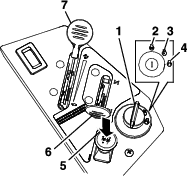
-
Engage the choke before starting a cold engine (if applicable).
Note: A warm or hot engine may not require choking.
-
Turn the ignition key to “START” to energize the starter. When the engine starts, release the key.
Important: Do Not engage the starter for more than 5 seconds at a time. If the engine fails to start, allow a 60 second cool-down period between attempts. Failure to follow these instructions can burn out the starter motor.
-
Once the engine starts, gradually move the choke control rearward (if applicable) as the engine warms. If the engine stalls or hesitates, slightly move the control forward for a few seconds.
Operating the Blades
The blade control switch, represented by a power take-off (PTO) symbol, engages and disengages power to the mower blades. This switch controls power to any attachments that draw power from the engine, including the mower deck and cutting blades.
Engaging the Blades
-
Move the motion control levers outward from the center T-slot position to engage the parking brake.
-
Move the throttle midway between the “SLOW” and “FAST” positions.
Note: Always engage the blades with the throttle in the midway position.
-
Pull out on the blade control switch, to the “ON” position, to engage the blades.
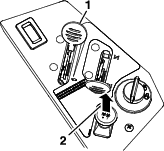
-
Move throttle to full forward position before mowing.
Disengaging the Blades
Set the throttle to the midway position. Push the blade control switch to “OFF” to disengage the blades.
Stopping the Engine
-
Bring the machine to a full stop.
-
Move the motion control levers to the center T-slot position and then outward to engage the parking brake. Disengage the blade control switch.
-
Place the throttle in the “FAST” position.
-
Allow the engine to run for a minimum of 15 seconds, then turn the ignition switch to the “OFF” position to stop the engine.
-
Remove the key to prevent children or other unauthorized persons from starting engine.
The Safety Interlock System
Caution
If the safety interlock switches are disconnected or damaged the machine could operate unexpectedly causing personal injury.
-
Do not tamper with the interlock switches.
-
Check the operation of the interlock switches daily and replace any damaged switches before operating the machine.
Understanding the Safety Interlock System
The safety interlock system is designed to prevent the engine from starting unless:
-
The blades are disengaged.
-
The motion control levers are moved outward to engage the parking brake.
The safety interlock system is designed to initiate engine shutdown when:
-
The parking brake is disengaged and the operator gets off machine.
-
The PTO is engaged and the operator gets off machine.
Check Safety Interlock System
Important: It is essential that operator safety mechanisms be connected and in proper operating condition prior to use.
Note: If machine does not pass any of these tests, Do Not operate. Contact an Authorized Service Dealer.
Note: To prevent engine cut-outs on rough terrain, the seat has a 1/2 second time delay before the engine begins to shutdown.
Check the Normal Engine Starting Chart
| System | |||||
| Parking Brake | PTO | Operator | Outcome | ||
| State of System | Engaged (Both motion control levers out) | Disengaged (Blades) | In seat or out of the seat | Starter should crank | |
 |  |   |  |
Check Engine Starting Circuit Chart
Note: In the Check Engine Starting Circuit Chart, the state of system item that is bold is being checked in each scenario.
| System | |||||
| Parking Brake | PTO (Blades) | Motion Control Levers | Operator | Outcome | |
| State of System | Engaged (Both motion control levers out) | Disengaged | Either right or left lever moved in | Operator in seat | Starter must not crank |
 |  |   |  |  |
|
| System | |||||
| Parking Brake | PTO | Operator | Outcome | ||
| State of System | Engaged (Both motion control levers out) | Engaged | Operator in seat | Starter must not crank | |
 |  |  |  |
||
Check Shutdown Circuit Chart
Note: The state of system item(s) that is bold is being checked in each scenario.
| System | |||||
| Engine | Parking Brake | PTO (Blades) | Operator | Outcome | |
| State of System | Running idle (1/3 throttle) | Disengaged (Both motion control levers in) | Disengaged | Raise off of seat (but don’t get off) | Engine must begin shutdown within 1 second |
 |  |  |  |  |
|
| Running idle (1/3 throttle) | Disengaged (Both motion control levers in) | Engaged | Raise off of seat (but don’t get off) | Engine must begin shutdown within 1 second | |
 |  |  |  |  |
|
Driving Forward or Backward
The throttle control regulates the engine speed as measured in rpm (revolutions per minute). Place the throttle control in the Fast position for best performance. Always operate in the Fast (full throttle) position.
Caution
Machine can spin very rapidly by positioning one lever too much ahead of the other. Operator may lose control of the machine, which may cause damage to the machine or injury.
-
Use caution when making turns.
-
Slow the machine down before making sharp turns.
Forward
-
Move the levers to the center, unlocked position.
-
To go forward, slowly push the motion control levers forward.

To go straight, apply equal pressure to both motion control levers Figure 13).
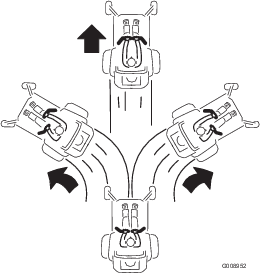
To turn, pull back on the motion control lever toward the direction you want to turn.
The farther you move the motion control levers in either direction, the faster the machine will move in that direction.
To stop, place the motion control levers in the center position (neutral operate) (reference Figure 12).
Backward
Note: Always use caution when backing up and turning.
-
Move the levers to the center, unlocked position.
-
To go backward, slowly pull the motion control levers rearward (Figure 14).
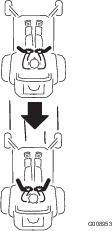
To go straight, apply equal pressure to both motion control levers.
To turn, release the pressure on the motion control lever toward the direction you want to turn.
To stop, push the motion control levers to neutral.
Stopping the Machine
To stop the machine:
-
Move the motion control levers to the center T-slot position and then outward to engage the parking brake. Disengage the blade control switch.
-
Place the throttle in the “FAST” position.
-
Allow the engine to run for a minimum of 15 seconds, then turn the ignition switch to the “OFF” position. Remember to remove the key from the ignition switch.
Caution
Children or bystanders may be injured if they move or attempt to operate the mower while it is unattended.
Always disengage the blade control switch, move the motion control levers outward to engage the parking brake, and remove the key when leaving the machine unattended, even if just for a few minutes.
Adjusting the Anti-Scalp Rollers
It is recommended to change the anti-scalp roller position when the height of cut has changed.
-
Park machine on level ground, move the motion control levers out to engage the parking brake, disengage the blade control switch, stop engine, and remove key and wait for all moving parts to stop before leaving the operating position.
-
After adjusting the height of cut, adjust the anti-scalp rollers by removing the nyloc nut.
-
Adjust the anti-scalp rollers for the normal operating conditions. Place rollers in one of the positions shown in Figure 16. Rollers will maintain 3/4 inches (19 mm) clearance to the ground to minimize gouging and roller wear or damage.
Note: For Maximum Deck Flotation, place the rollers one hole position lower. Rollers should maintain 1/4 inch (6.35 mm) clearance to the ground. Do Not adjust rollers to support the deck.
-
For 34 and 42 Inch Models:

-
For 50 and 54 Inch Models:
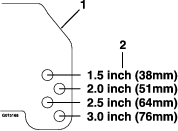
-
-
Torque hardware to 27-33 ft-lb (37-45 N-m) or loss of roller may result.
Positioning the Seat
The seat can move forward and backward. Position the seat where you have the best control of the machine and are most comfortable.
-
E-Series Units:
-
Tip the seat forward.
-
Loosen the adjustment bolts.
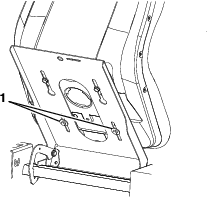
-
Move the seat to the desired position and tighten bolts.
-
Tip the seat back to the closed position.
-
-
S-Series Units:
-
Push the adjustment lever towards the center of the machine to release the seat adjuster track (Figure 18).
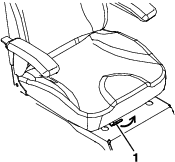
-
Move the seat to the desired position and release the lever to lock in that position.
-
Changing the Seat Ride Suspension
The number of seat springs can be changed to maximize rider comfort. More springs should be used with heavier operators and on rough terrain. Fewer springs should be used with lighter operators and when mowing smooth, well established lawns. Always keep the number of springs on the left and right side the same when adding and removing springs.
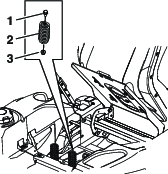
Up to five springs can be secured to the seat box with a nut and bolt, see Figure 19.
Refer to your Parts Manual for spring and hardware part numbers.
Adjusting the Motion Control Levers
Adjusting the Height
The motion control levers can be adjusted higher or lower for maximum operator comfort.
-
Remove the hardware holding the control lever to the control arm shaft (Figure 20).
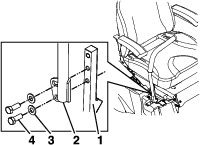
-
Move the control lever to the next set of holes. Secure the lever with the hardware.
-
Repeat the adjustment for the opposite control lever.
Adjusting the Tilt
The motion control levers can be tilted fore or aft for maximum operator comfort.
-
Loosen the upper bolt holding the control lever to the control arm shaft.
-
Loosen the lower bolt just enough to pivot the control lever fore or aft (Figure 20). Tighten both bolts to secure the control in the new position.
-
Repeat the adjustment for the opposite control lever.
Adjusting the Tracking
When driving the machine forward full speed across a flat, level surface, if the machine pulls to one side, adjust the tracking.
If the machine pulls to the left, adjust the right motion-control lever; if the machine pulls to the right, adjust the left motion-control lever.
Note: You can only adjust the tracking for driving forward.
-
Park machine on level ground, move the motion control levers out to engage the parking brake, disengage the blade control switch, stop engine, and remove key. Wait for all moving parts to stop before leaving the operator’s position.
-
Locate the tracking adjustment bolt near the motion control lever on the side that needs adjusting (Figure 21).
Note: Raise the seat for easier access to the adjustment bolt.
-
Rotate the bolt to decrease the speed for the wheel.
Note: Rotate the bolt a small amount to make minor adjustments.
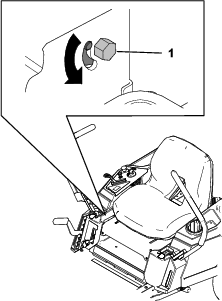
-
Start the machine and drive forward across a flat, level surface with the motion control levers fully forward to check if the machine tracks straight. Repeat the procedure as needed.
Pushing the Machine by Hand
Important: Always push the machine by hand. Never tow the machine because damage may occur.
To Push the Machine
-
Park machine on level ground, move the motion control levers out to engage the parking brake, disengage the blade control switch, stop engine, and remove key. Wait for all moving parts to stop before leaving the operator’s position.
-
Locate the bypass levers on the frame on both sides of the engine.
-
Move the bypass levers forward through the key hole and down to lock them in place as shown in Figure 22. Ensure this is done for each lever.
-
Turn the ignition key “ON” but Do Not start the engine. Move one motion control lever inward to release the parking brake.
The machine is now able to be pushed by hand.
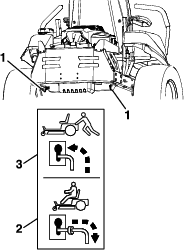
-
When finished, ensure the key has been returned to the “OFF” position to avoid draining the battery charge.
To Operate the Machine
Move the bypass levers rearward through the key hole and down to lock them in place as shown in Figure 22. Ensure this is done for each lever.
Side Discharge
The mower has a hinged discharge deflector that disperses clippings to the side and down toward the turf.
Danger
Without the discharge deflector, mulch kit, or entire grass collection system mounted in place, you and others are exposed to blade contact and thrown debris. Contact with rotating mower blade(s) and thrown debris will cause injury or death.
-
Never remove the discharge deflector from the mower because the discharge deflector routes material down toward the turf. If the discharge deflector is ever damaged, replace it immediately.
-
Never put your hands or feet under the mower.
-
Never try to clear discharge area or mower blades unless you move the blade control switch to Off and rotate the ignition key to Off. Also remove the key and pull the wire off the spark plug(s).
After Operation
General Safety
-
Park machine on level ground, move the motion control levers out to engage the parking brake, disengage the blade control switch, stop engine, and remove key. Wait for all moving parts to stop before leaving the operator’s position. Allow the machine to cool before servicing, adjusting, fueling, cleaning, or storing.
-
Clean grass, leaves, excessive grease or oil, and other debris from the mower deck, muffler, drives, grass catcher, and engine area to help prevent fires.
-
Close the fuel shut-off valve before storing or transporting the machine.
Transporting
Transporting the Machine
Use a heavy-duty trailer or truck to transport the machine. Ensure that the trailer or truck has all necessary lighting and marking as required by law. Thoroughly read all of the safety instructions. Knowing this information could help you, your family, pets, or bystanders avoid injury.
To transport the machine:
-
Lock the brake and block the wheels.
-
Be sure the fuel shut-off valve is closed.
-
Securely fasten the machine to the trailer or truck with straps, chains, cable, or ropes. Only use the designated tie-down locations on the mower as shown in Figure 23. Use these locations even when transporting the mower with an attached accessory. Using non-designated locations may cause damage to the mower and/or attachment.

-
Secure a trailer to the towing vehicle with safety chains.
Warning
Driving on the street or roadway without turn signals, lights, reflective markings, or a slow moving vehicle emblem is dangerous and can lead to accidents causing personal injury.
Do not drive machine on a public street or roadway.
Loading the Machine
Use extreme caution when loading or unloading machines onto a trailer or a truck. Use a full-width ramp that is wider than the machine for this procedure. Back up ramps and drive forward down ramps (Figure 24).

Important: Do not use narrow individual ramps for each side of the machine.
Ensure the ramp is long enough so that the angle with the ground does not exceed 15 degrees (Figure 24). On flat ground, this requires a ramp to be at least four times (4X) as long as the height of the trailer or truck bed to the ground. A steeper angle may cause mower components to get caught as the unit moves from the ramp to the trailer or truck. Steeper angles may also cause the machine to tip or lose control. If loading on or near a slope, position the trailer or truck so that it is on the down side of the slope and the ramp extends up the slope. This will minimize the ramp angle.
Warning
Loading a machine onto a trailer or truck increases the possibility of tip-over and could cause serious injury or death.
-
Use extreme caution when operating a machine on a ramp.
-
Use only a full-width ramp; do not use individual ramps for each side of the machine.
-
Do not exceed a 15-degree angle between the ramp and the ground or between the ramp and the trailer or truck.
-
Ensure the length of ramp is at least four times (4X) as long as the height of the trailer or truck bed to the ground. This will ensure that ramp angle does not exceed 15 degrees on flat ground.
-
Back up ramps and drive forward down ramps.
-
Avoid sudden acceleration or deceleration while driving the machine on a ramp as this could cause a loss of control or a tip-over situation.
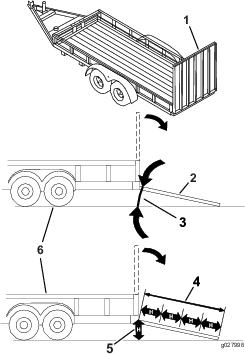
Towing the Machine
-
Do not attach towed equipment except at the hitch point.
-
Follow the attachment manufacturer's recommendation for weight limits for towed equipment and towing on slopes. Towed weight must not exceed the weight of the machine, operator, and ballast; otherwise hydrostatic transmission failure may occur. Use counterweights or wheel weights as described in the attachment manufacturer's manual.
-
Never allow children or others in or on towed equipment.
-
On slopes, the weight of the towed equipment may cause loss of traction, increased risk of rollover, and loss of control. Reduce the towed weight and slow down.
-
Stopping distance increases with the weight of the towed load. Travel slowly and allow extra distance to stop.
-
Make wide turns to keep the attachment clear of the machine.
Operating Tips
Fast Throttle Setting
For best mowing and maximum air circulation, operate the engine at the Fast position. Air is required to thoroughly cut grass clippings, so Do Not set the height-of-cut so low as to totally surround the mower by uncut grass. Always try to have one side of the mower free from uncut grass, which allows air to be drawn into the mower.
Cutting a Lawn for the First Time
Cut grass slightly longer than normal to ensure that the cutting height of the mower does not scalp any uneven ground. However, the cutting height used in the past is generally the best one to use. When cutting grass longer than six inches tall, you may want to cut the lawn twice to ensure an acceptable quality of cut.
Cut 1/3 of the Grass Blade
It is best to cut only about 1/3 of the grass blade. Cutting more than that is not recommended unless grass is sparse, or it is late fall when grass grows more slowly.
Mowing Direction
Alternate mowing direction to keep the grass standing straight. This also helps disperse clippings which enhances decomposition and fertilization.
Mow at Correct Intervals
Normally, mow every four days. But remember, grass grows at different rates at different times. So to maintain the same cutting height, which is a good practice, mow more often in early spring. As the grass growth rate slows in mid summer, mow less frequently. If you cannot mow for an extended period, first mow at a high cutting height; then mow again two days later at a lower height setting.
Cutting Speed
To improve cut quality, use a slower ground speed.
Avoid Cutting Too Low
If the cutting width of the mower is wider than the mower you previously used, raise the cutting height to ensure that uneven turf is not cut too short.
Long Grass
If the grass is ever allowed to grow slightly longer than normal, or if it contains a high degree of moisture, raise the cutting height higher than usual and cut the grass at this setting. Then cut the grass again using the lower, normal setting.
When Stopping
If the machine’s forward motion must be stopped while mowing, a clump of grass clippings may drop onto your lawn. To avoid this, move onto a previously cut area with the blades engaged.
Keep the Underside of the Mower Clean
Clean clippings and dirt from the underside of the mower after each use. If grass and dirt build up inside the mower, cutting quality will eventually become unsatisfactory.
Blade Maintenance
Maintain a sharp blade throughout the cutting season because a sharp blade cuts cleanly without tearing or shredding the grass blades. Tearing and shredding turns grass brown at the edges, which slows growth and increases the chance of disease. Check the cutter blades daily for sharpness, and for any wear or damage. File down any nicks and sharpen the blades as necessary. If a blade is damaged or worn, replace it immediately with a genuine Exmark replacement blade. Only Exmark blades are to be used with this unit. No other blades are approved.
Maintenance
Note: Determine the left and right sides of the machine from the normal operating position.
Maintenance Safety
-
Park machine on level ground, move the motion control levers out to engage the parking brake, disengage the blade control switch, stop engine, and remove key. Wait for all moving parts to stop before leaving the operator’s position. Allow the machine to cool before servicing, adjusting, fueling, cleaning, or storing.
-
If you leave the key in the switch, someone could accidently start the engine and seriously injure you or other bystanders. Remove the key from the switch before you perform any maintenance.
-
Never allow untrained personnel to service machine.
-
Disconnect battery or remove spark plug wire before making any repairs. Disconnect the negative terminal first and the positive last. Reconnect positive first and negative last.
-
Keep all guards, shields, switches, and all safety devices in place and in proper working condition. Frequently check for worn or deteriorating components and replace them with genuine Exmark parts when necessary.
Warning
Removal or modification of original equipment, parts and/or accessories may alter the warranty, controllability, and safety of the machine. Unauthorized modifications to the original equipment or failure to use original Exmark parts could lead to serious injury or death. Unauthorized changes to the machine, engine, fuel or venting system, may violate applicable safety standards such as: ANSI, OSHA and NFPA and/or government regulations such as EPA and CARB.
Warning
Hydraulic fluid escaping under pressure can penetrate skin and cause injury. Fluid accidentally injected into the skin must be surgically removed within a few hours by a doctor familiar with this form of injury or gangrene may result.
-
If equipped, make sure all hydraulic fluid hoses and lines are in good condition and all hydraulic connections and fittings are tight before applying pressure to hydraulic system.
-
Keep body and hands away from pinhole leaks or nozzles that eject high pressure hydraulic fluid.
-
Use cardboard or paper, not your hands, to find hydraulic leaks.
-
Safely relieve all pressure in the hydraulic system by placing the motion control levers in neutral and shutting off the engine before performing any work on the hydraulic system.
-
-
Use care when checking blades. Wrap the blade(s) or wear gloves, and use caution when servicing them. Only replace damaged blades. Never straighten or weld them.
-
Do not rely solely on mechanical or hydraulic jacks for support. Use adequate jack stands.
-
Carefully release pressure from components with stored energy
-
Keep your hands and feet away from moving parts or hot surfaces. If possible, do not make adjustments with the engine running.
-
Keep all parts in good working condition and all hardware tightened, especially the blade-attachment hardware.
Recommended Maintenance Schedule(s)
| Maintenance Service Interval | Maintenance Procedure |
|---|---|
| After the first 5 hours |
|
| Before each use or daily |
|
| Every 25 hours |
|
| Every 50 hours |
|
| Every 100 hours |
|
| Every 200 hours |
|
| Every 500 hours |
|
| Before storage |
|
| Monthly |
|
Periodic Maintenance
Raising the Seat
Place the motion control levers out to the neutral lock position, engage the parking brake, and lift the seat forward.
The following components can be accessed by raising the seat:
-
Serial plate
-
Service decal
-
Seat adjustment bolts
-
Fuel filter
-
Battery and battery cables
Lubrication
Greasing the Bearings
| Maintenance Service Interval | Maintenance Procedure |
|---|---|
| Every 25 hours |
|
Grease Type: NLGI grade #2 multi-purpose gun grease.
Grease the front caster wheels (Figure 26).

-
Park machine on level ground, move the motion control levers out to engage the parking brake, disengage the blade control switch, stop engine, and remove key. Wait for all moving parts to stop before leaving the operator’s position.
-
Clean the grease fittings with a rag. Make sure to scrape any paint off of the front of the fitting(s).
-
Wipe up any excess grease.
Engine Safety
Warning
The engine can become very hot, especially the muffler and exhaust components. Touching a hot engine can cause severe burns.
Allow the engine to cool completely before service or making repairs around the engine area.
Do Not change the engine governor setting or overspeed the engine.
Engine Maintenance
| Maintenance Service Interval | Maintenance Procedure |
|---|---|
| Before each use or daily |
|
Important: For Kohler Engines, refer to the Engine Owner’s Manual for additional maintenance procedures.
Important: If you are using a machine with an Exmark engine above 5,000 ft (1500 m) for a continuous period, ensure that the High Altitude Kit has been installed so that the engine meets CARB/EPA emission regulations. The High Altitude Kit increases engine performance while preventing spark fouling, hard starting, and increased emissions. Once you have installed the kit, attach the high-altitude label next to the serial decal on the machine (reference Figure 1). Contact an Authorized Service Dealer to obtain the proper High Altitude Kit and high-altitude label for your machine. To locate a dealer convenient to you, access our web site at http://www.Exmark.com or contact our Exmark Customer Care Department at the number(s) listed in your Emission Control Warranty Statement. Remove the kit from the engine and restore the engine to its original factory configuration when running the engine under 5,000 ft (1500 m). Do Not operate an engine that has been converted for high-altitude use at a lower altitudes; otherwise, you could overheat and damage the engine. If you are unsure whether or not your machine has been converted for high altitude use, look for the following label:

Servicing an Exmark Engine
Servicing the Air Cleaner–Exmark Engine
| Maintenance Service Interval | Maintenance Procedure |
|---|---|
| Every 25 hours |
|
| Every 100 hours |
|
| Every 200 hours |
|
Check the air cleaner daily or before starting the engine. Check for a buildup of dirt and debris around the air cleaner system. Keep this area clean. Also check for loose or damaged components. Replace all bent or damaged air cleaner components.
Note: Operating the engine with loose or damaged air cleaner components could allow unfiltered air into the engine causing premature wear and failure.
Note: Service the air cleaner more often under extremely dusty, dirty conditions.
Removing the Elements:
-
Park machine on level ground, move the motion control levers out to engage the parking brake, disengage the blade control switch, stop engine, and remove key. Wait for all moving parts to stop before leaving the operator’s position.
-
Clean around the air cleaner cover to prevent dirt from getting into the engine and causing damage.
-
Lift the cover and rotate the air-cleaner assembly out of the engine (see Figure 28 and Figure 29).
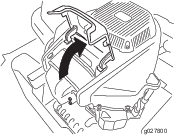
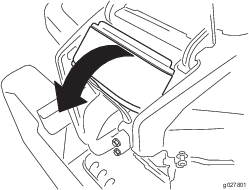
-
Separate the foam and paper elements.
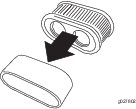
Cleaning the Foam and Paper Elements:
Foam Element:
Wash the foam element with water.
Important: Replace the foam element if it is torn or worn.
Paper Element:
-
Lightly tap the element on a flat surface to remove dust and dirt.
-
Inspect the element for tears, an oily film, and damage to the seal.
Important: Do not clean the paper element with pressurized air or liquids, such as solvent, gas, or kerosene. Replace the paper element if it is damaged or cannot be cleaned thoroughly.
To learn more about the Exmark twin-cylinder engine go to https://exmark.com/engines or scan the QR code.

Checking the Engine Oil Level
| Maintenance Service Interval | Maintenance Procedure |
|---|---|
| Before each use or daily |
|
Important: Do not overfill the crankcase with oil and run the engine; engine damage may result.
-
Park machine on level ground, move the motion control levers out to engage the parking brake, disengage the blade control switch, stop engine, and remove key. Wait for all moving parts to stop before leaving the operator’s position.
-
Make sure the engine is stopped, level, and is cool so the oil has had time to drain into the sump.
-
To keep dirt, grass clippings, etc., out of the engine, clean the area around the oil fill cap/dipstick before removing it.
-
Check the engine oil level.
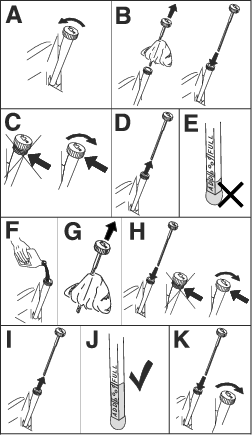
-
If the level is low, wipe off the area around the oil fill cap, remove cap/dipstick and add oil to the “FULL” mark on the dipstick. Exmark 4-Cycle Premium Engine Oil is recommended; refer to the following information for an appropriate API rating and viscosity. Always check the level with the dipstick before adding more oil. Do Not overfill.
-
Crankcase Capacity: 2.4 L (2.5 qt)
-
Recommended Oil Type: Exmark 4-Cycle Premium Engine Oil
– API service SF, SG, SH, SJ, or SL

Note: To prevent extensive engine wear or damage, always maintain the proper oil level in the crankcase. Never operate the engine with the oil level below the “ADD” mark or over the “FULL” mark on the dipstick.
-
Changing the Engine Oil
| Maintenance Service Interval | Maintenance Procedure |
|---|---|
| After the first 5 hours |
|
| Every 100 hours |
|
-
Park the machine so that the drain side is slightly lower than the opposite side to ensure the oil drains completely.
-
Start the engine and let it run until warm. This warms the oil so it drains better.
-
Disengage the blade control switch and ensure the parking brake is engaged.
-
Stop the engine, remove the key, and wait for all moving parts to stop before leaving the operating position.
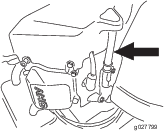
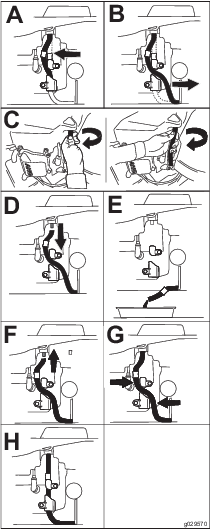
-
Change the engine oil filter. Apply a thin film of clean Exmark 4-Cycle Premium Engine Oil to the rubber gasket on the new filter.
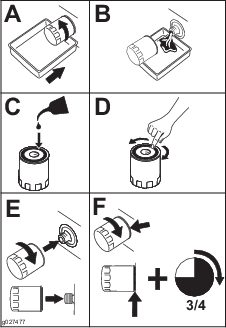
Note: Ensure the oil filter gasket touches the engine, then an extra 3/4 turn is completed.
Note: Dispose of the used oil at a recycling center.
-
Slowly pour approximately 80% of the specified oil into the filler tube—use oil recommended in the Checking the Engine Oil Level section.
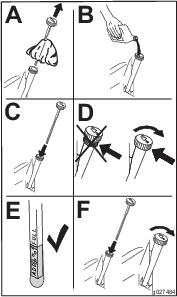
-
Check the oil level; refer to Checking the Engine Oil Level section.
-
Start the engine and check for leaks.
Servicing the Spark Plug
| Maintenance Service Interval | Maintenance Procedure |
|---|---|
| Every 100 hours |
|
| Every 200 hours |
|
Ensure that the air gap between the center and side electrodes is correct before installing the spark plug. Use a spark plug wrench for removing and installing the spark plug and a gapping tool or feeler gauge to check and adjust the air gap. Install a new spark plug if necessary.
Type: Champion RN9YC or equivalent
Air Gap: 0.030 inch (.76 mm)
Removing the Spark Plug
-
Disengage the PTO and ensure the parking brake is engaged.
-
Stop the engine, remove the key, and wait for all moving parts to stop before leaving the operating position.
-
Disconnect the wire from the spark plug.
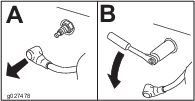
Note: Due to the deep recess around the spark plug, blowing out the cavity with compressed air is usually the most effective method for cleaning. The spark plug is most accessible when the blower housing is removed for cleaning.
Installing the Spark Plug–Exmark Engine
-
Install the spark plug. Make sure that the air gap is set correctly.
-
Tighten the spark plug to 18.5–22.1 ft-lb (25–30 N-m).
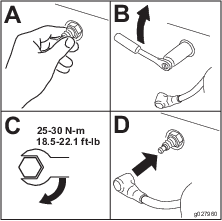
-
Push the wire onto the spark plug.
Checking the Spark Plug
-
Inspect the spark plug
Note: If you see light brown or gray on the insulator, the engine is operating properly. A black coating on the insulator usually means the air cleaner is dirty.
Important: Do Not clean the spark plug(s). Always replace the spark plug(s) when it has: a black coating, worn electrodes, an oily film, or cracks.
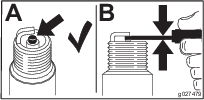
-
Check the gap between the center and side electrodes.
-
Set the gap to 0.030 inch (.76 mm).
Servicing a Kohler Engine
Servicing the Air Cleaner-Kohler Engine
| Maintenance Service Interval | Maintenance Procedure |
|---|---|
| Every 50 hours |
|
| Every 100 hours |
|
Note: Operating the engine with loose or damaged air-cleaner components could allow unfiltered air into the engine, causing premature wear and failure.
Removing the Elements:
-
Park machine on level ground, move the motion control levers out to engage the parking brake, disengage the blade control switch, stop engine, and remove key. Wait for all moving parts to stop before leaving the operator’s position.
-
Move the motion control levers out to engage parking brake, stop the engine, remove the key, and wait for all moving parts to stop before leaving the operating position.
-
Clean around the air cleaner cover to prevent dirt from getting into the engine and causing damage.
-
Rotate the latches outward.
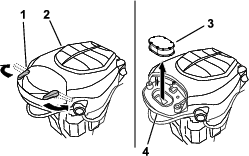
-
Remove the cover to access the air-cleaner element.
-
Separate the foam and paper elements (Figure 42).

Cleaning the Foam and Paper Elements:
Foam Element:
-
Wash the foam element with water.
-
Dry the element by squeezing it in a clean cloth.
Important: Replace the foam element if it is torn or worn.
-
Lightly oil the foam element using new engine oil and squeeze out any excess oil.
Paper Element:
-
Lightly tap the element on a flat surface to remove dust and dirt.
-
Inspect the element for tears, an oily film, and damage to the seal.
Important: Do not clean the paper element with pressurized air or liquids, such as solvent, gas, or kerosene. Replace the paper element if it is damaged or cannot be cleaned thoroughly.
-
Replace the paper element if it is damaged.
Installing the Air Cleaner
-
Install the foam pre-cleaner element over the paper element.
Note: Ensure that you do not damage the elements.
-
Install the air cleaner elements onto the air cleaner base.
-
Install the cover and secure it with the retaining clamps (see Figure 41).
Checking the Engine Oil Level
| Maintenance Service Interval | Maintenance Procedure |
|---|---|
| Before each use or daily |
|
Important: Do not overfill the crankcase with oil and run the engine; engine damage may result.
-
Park machine on level ground, move the motion control levers out to engage the parking brake, disengage the blade control switch, stop engine, and remove key. Wait for all moving parts to stop before leaving the operator’s position.
-
Make sure the engine is stopped, level, and is cool so the oil has had time to drain into the sump.
-
To keep dirt, grass clippings, etc., out of the engine, clean the area around the oil fill cap/dipstick before removing it.
-
Check the engine oil level.
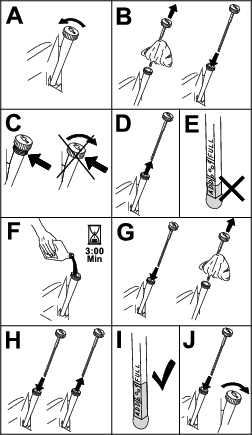
-
If the level is low, wipe off the area around the oil fill cap, remove cap/dipstick and add oil to the “FULL” mark on the dipstick. Exmark 4-Cycle Premium Engine Oil is recommended; refer to the following information for an appropriate API rating and viscosity. Always check the level with the dipstick before adding more oil. Do Not overfill.
-
Crankcase Capacity: 1.9 L (64 oz) with oil filter
-
Recommended Oil Type: Exmark 4-Cycle Premium Engine Oil
– API service SJ or higher
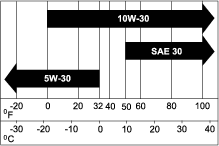
Note: To prevent extensive engine wear or damage, always maintain the proper oil level in the crankcase. Never operate the engine with the oil level below the “ADD” mark or over the “FULL” mark on the dipstick.
-
Changing the Engine Oil
| Maintenance Service Interval | Maintenance Procedure |
|---|---|
| After the first 5 hours |
|
| Every 100 hours |
|
-
Park the machine so that the drain side is slightly lower than the opposite side to ensure the oil drains completely.
-
Start the engine and let it run until warm. This warms the oil so it drains better.
-
Move the motion control levers out to engage the parking brake, disengage the blade control switch, stop engine, and remove key. Wait for all moving parts to stop before leaving the operator’s position.
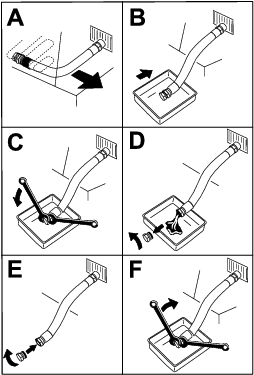
-
Change the engine oil filter. Apply a thin film of clean Exmark 4-Cycle Premium Engine Oil to the rubber gasket on the new filter.

Note: Ensure the oil filter gasket touches the engine, then an extra 3/4 turn is completed.
Note: Dispose of the used oil at a recycling center.
-
Slowly pour approximately 80% of the specified oil into the filler tube—use oil recommended in the Checking the Engine Oil Level section.
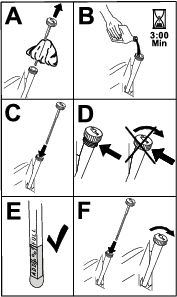
-
Check the oil level; refer to Checking the Engine Oil Level section.
-
Start the engine and check for leaks.
Servicing the Spark Plug
| Maintenance Service Interval | Maintenance Procedure |
|---|---|
| Every 100 hours |
|
| Every 500 hours |
|
Ensure that the air gap between the center and side electrodes is correct before installing the spark plug. Use a spark plug wrench for removing and installing the spark plug and a gapping tool or feeler gauge to check and adjust the air gap. Install a new spark plug if necessary.
Type: Champion® RN9YC or equivalent
Air Gap: 0.030 inch (.76 mm)
Removing the Spark Plug
-
Park machine on level ground, move the motion control levers out to engage the parking brake, disengage the blade control switch, stop engine, and remove key. Wait for all moving parts to stop before leaving the operator’s position.
-
Disconnect the wire from the spark plug.

Due to the deep recess around the spark plug, blowing out the cavity with compressed air is usually the most effective method for cleaning. The spark plug is most accessible when the blower housing is removed for cleaning.
Installing the Spark Plug–Exmark Engine
-
Install the spark plug. Make sure that the air gap is set correctly.
-
Tighten the spark plug to 15 ft-lb (20 N-m).
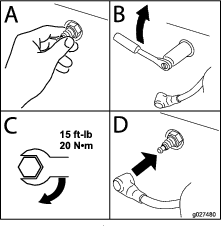
-
Push the wire onto the spark plug.
Checking the Spark Plug
-
Inspect the spark plug
Note: If you see light brown or gray on the insulator, the engine is operating properly. A black coating on the insulator usually means the air cleaner is dirty.
Important: Do Not clean the spark plug(s). Always replace the spark plug(s) when it has: a black coating, worn electrodes, an oily film, or cracks.

-
Check the gap between the center and side electrodes.
-
Set the gap to 0.030 inch (.76 mm).
Cleaning the Blower Housing
| Maintenance Service Interval | Maintenance Procedure |
|---|---|
| Every 100 hours |
|
To ensure proper cooling, make sure the grass screen, cooling fins, and other external surfaces of the engine are kept clean at all times.
-
Remove the blower housing and any other cooling shrouds.
-
Clean the cooling fins and external surfaces as necessary.
-
Make sure the cooling shrouds are reinstalled
Important: Operating the engine with a blocked grass screen, dirty or plugged cooling fins, and/or cooling shrouds removed, will cause engine damage due to overheating.
Fuel System Maintenance
Replacing the Fuel Filter
| Maintenance Service Interval | Maintenance Procedure |
|---|---|
| Every 100 hours |
|
Danger
In certain conditions, gasoline is extremely flammable and highly explosive. A fire or explosion from gasoline can burn you and others and can damage property.
-
Perform any fuel related maintenance when the engine is cold. Do this outdoors in an open area. Wipe up any gasoline that spills.
-
Never smoke when draining gasoline, and stay away from an open flame or where a spark may ignite the gasoline fumes.
Never install a dirty filter if it is removed from the fuel line.
-
Park machine on level ground, move the motion control levers out to engage the parking brake, disengage the blade control switch, stop engine, and remove key. Wait for all moving parts to stop before leaving the operator’s position.
-
The fuel filter is in the fuel line between the tank and engine.
-
Squeeze the ends of the hose clamps together and slide them away from the filter.
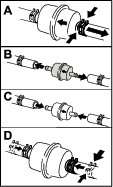
-
Remove the filter from the fuel lines.
-
Install a new filter with the flow direction arrow coming from the fuel tank and pointing to the engine. Move the hose clamps close to the filter to secure it in place.
Electrical System Maintenance
| Maintenance Service Interval | Maintenance Procedure |
|---|---|
| Monthly |
|
Charging the Battery
| Maintenance Service Interval | Maintenance Procedure |
|---|---|
| Before storage |
|
Removing the Battery
Warning
Battery terminals or metal tools could short against metal machine components causing sparks. Sparks can cause the battery gasses to explode, resulting in personal injury.
-
When removing or installing the battery, Do Not allow the battery terminals to touch any metal parts of the machine.
-
Do Not allow metal tools to short between the battery terminals and metal parts of the machine.
Danger
Charging or jump starting the battery may produce explosive gases. Battery gases can explode causing serious injury.
-
Keep sparks, flames, or cigarettes away from battery.
-
Ventilate when charging or using battery in an enclosed space.
-
Make sure venting path of battery is always open once battery is filled with acid.
-
Always shield eyes and face from battery.
Danger
Battery electrolyte contains sulfuric acid, which is poisonous and can cause severe burns. Swallowing electrolyte can be fatal or if it touches skin can cause severe burns.
-
Wear safety glasses to shield eyes, and rubber gloves to protect skin and clothing when handling electrolyte.
-
Do Not swallow electrolyte.
-
In the event of an accident, flush with water and call a doctor immediately.
Caution
If the ignition is in the “ON” position there is potential for sparks and engagement of components. Sparks could cause an explosion or moving parts could accidentally engage causing personal injury.
Be sure ignition switch is in the “OFF” position before charging the battery.
-
Park machine on level ground, move the motion control levers out to engage the parking brake, disengage the blade control switch, stop engine, and remove key. Wait for all moving parts to stop before leaving the operator’s position.
-
Raise the seat.
-
Disconnect the negative (black) ground cable from the battery post (Figure 52). Retain all fasteners.
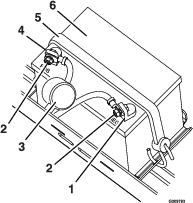
Warning
Incorrect battery cable routing could damage the machine and cables causing sparks. Sparks can cause the battery gasses to explode, resulting in personal injury.
-
Always disconnect the negative (black) battery cable before disconnecting the positive (red) cable.
-
Always connect the positive (red) battery cable before connecting the negative (black) cable.
-
-
Slide the rubber cover up the positive (red) cable. Disconnect the positive (red) cable from the battery post. Retain all fasteners.
-
Remove the battery strap (Figure 52) and lift the battery from the battery tray.
Checking the Battery Charge
-
Remove the battery from the chassis; refer to Removing the Battery.
-
Allowing batteries to stand for an extended period without recharging them will result in reduced performance and service life. To preserve optimum battery performance and life, recharge batteries in storage when the open circuit voltage drops to 12.4 volts.
Note: To prevent damage due to freezing, battery should be fully charged before putting away for winter storage.
-
Check the voltage of the battery with a digital voltmeter. Locate the voltage reading of the battery in the table below and charge the battery for the recommended time interval to bring the charge up to a full charge of 12.6 volts or greater.
Important: Make sure the negative battery cable is disconnected and the battery charger used for charging the battery has an output of 16 volts and 7 amps or less to avoid damaging the battery (see chart below for recommended charger settings).
Voltage Reading Percent Charge Maximum Charger Settings Charging Interval 12.6 or greater 100% 16 volts/7 amps No Charging Required 12.4 – 12.6 75–100% 16 volts/7 amps 30 Minutes 12.2 – 12.4 50–75% 16 volts/7 amps 1 Hour 12.0–12.2 25–50% 14.4 volts/4 amps 2 Hours 11.7–12.0 0–25% 14.4 volts/4 amps 3 Hours 11.7 or less 0% 14.4 volts/2 amps 6 Hours or More
Recommended Jump Starting Procedure
-
Check the weak battery for terminal corrosion (white, green, or blue “snow”), it must be cleaned off prior to jump starting. Clean and tighten connections as necessary.
Caution
Corrosion or loose connections can cause unwanted electrical voltage spikes at anytime during the jump starting procedure.
Do Not attempt to jump start with loose or corroded battery terminals or damage to the engine may occur.
Danger
Jump starting a weak battery that is cracked, frozen, has low electrolyte level, or an open/shorted battery cell, can cause an explosion resulting in serious personal injury.
Do Not jump start a weak battery if these conditions exist.
-
Make sure the booster is a good and fully charged lead acid battery at 12.6 volts or greater. Use properly sized jumper cables (4 to 6 AWG) with short lengths to reduce voltage drop between systems. Make sure the cables are color coded or labeled for the correct polarity.
Caution
Connecting the jumper cables incorrectly (wrong polarity) can immediately damage the electrical system.
Be certain of battery terminal polarity and jumper cable polarity when hooking up batteries.
Note: The following instructions are adapted from the SAE J1494 Rev. Dec. 2001 – Battery Booster Cables – Surface Vehicle Recommended Practice (SAE – Society of Automotive Engineers).
Warning
Batteries contain acid and produce explosive gases.
-
Shield the eyes and face from the batteries at all times.
-
Do Not lean over the batteries.
Note: Be sure the vent caps are tight and level. Place a damp cloth, if available, over any vent caps on both batteries. Be sure the vehicles do not touch and that both electrical systems are off and at the same rated system voltage. These instructions are for negative ground systems only.
-
-
Connect the positive (+) cable to the positive (+) terminal of the discharged battery that is wired to the starter or solenoid as shown in .
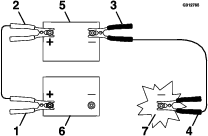
-
Connect the other end of the positive cable to the positive terminal of the booster battery.
-
Connect the black negative (–) cable to the other terminal (negative) of the booster battery.
-
MAKE THE FINAL CONNECTION ON THE ENGINE BLOCK OF THE STALLED VEHICLE (NOT TO THE NEGATIVE POST) AWAY FROM THE BATTERY. STAND BACK.
-
Start the vehicle and remove the cables in the reverse order of connection (the engine block (black) connection is the first to disconnect).
Installing the Battery
-
Position the battery in the tray with the terminal posts toward the operating position (Figure 52).
-
Install the positive (red) battery cable to the positive (+) battery terminal using the fasteners removed previously.
-
Install the negative battery cable to the negative (-) battery terminal using the fasteners removed previously.
-
Slide the red terminal boot onto the positive (red) battery post.
-
Secure the battery with the strap (Figure 52).
Servicing the Fuses
The electrical system is protected by fuses. It requires no maintenance; however, if a fuse blows, check the component/circuit for a malfunction or short.
Fuse:
-
Main F1-25 amp, blade-type
-
Charge Circuit F2-15 amp, blade-type
-
Flip up the seat to access the main wiring harness and fuse block.
-
To replace a fuse, pull out on the fuse to remove it (Figure 54).
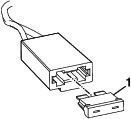
-
Return the seat to the operating position.
Drive System Maintenance
Checking the Tire Pressure
| Maintenance Service Interval | Maintenance Procedure |
|---|---|
| Every 25 hours |
|
Maintain the air pressure in the front and rear tires as specified. Uneven tire pressure can cause uneven cut. Check the pressure at the valve stem (Figure 55).
Check the tires when they are cold to get the most accurate pressure reading.
Rear Tires: 13 psi (90 kPa)
Front Tires (caster wheels): 13 psi (90 kPa)

Releasing the Electric Brake
The electric brake can be manually released by rotating the link arms forward. Once the electric brake is energized, the brake resets.
-
Turn the key to the “OFF” position and remove the key.
-
Disconnect the battery.
-
Locate the shaft on the electric brake where the brake link arms are connected.
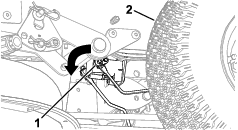
-
Rotate the shaft forward to release the brake.
-
Connect the battery after moving the machine.
Mower Maintenance
Servicing the Cutting Blades
| Maintenance Service Interval | Maintenance Procedure |
|---|---|
| Before each use or daily |
|
Maintain sharp blades throughout the cutting season because sharp blades cut cleanly without tearing or shredding the grass blades. Tearing and shredding turns grass brown at the edges, which slows growth and increases the chance of disease.
Check the cutter blades daily for sharpness, and for any wear or damage. File down any nicks and sharpen the blades as necessary. If a blade is damaged or worn, replace it immediately with a genuine Exmark replacement blade. For convenient sharpening and replacement, you may want to keep extra blades on hand.
Warning
A worn or damaged blade can break, and a piece of the blade could be thrown into the operator's or bystander's area, resulting in serious personal injury or death.
-
Inspect the blade periodically for wear or damage.
-
Replace a worn or damaged blade.
Before Inspecting or Servicing the Blades
Park the machine on a level surface, disengage the blade control switch, and move the motion control levers outward to engage the parking brake. Stop the engine, remove the key, and disconnect the spark plug wire(s) from the spark plug(s).
Inspecting the Blades
-
Inspect the cutting edges (Figure 57). If the edges are not sharp or have nicks, remove and sharpen the blades; refer to Sharpening the Blades.
-
Inspect the blades, especially the curved area. If you notice any damage, wear, or a slot forming in this area (item 3 in Figure 57), immediately install a new blade.
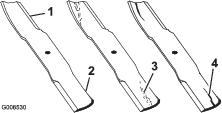
Checking for Bent Blades
Note: The machine must be on a level surface for the following procedure.
-
Raise the mower deck to the highest height-of-cut position; also considered the 'transport' position.
-
While wearing thickly padded gloves or other adequate hand protection slowly rotate blade to be measure into a position that allows effective measurement of the distance between the cutting edge and the level surface the machine is on.
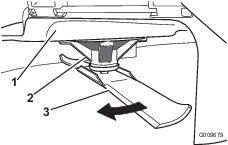
-
Measure from the tip of the blade to the flat surface here.

-
Rotate the same blade 180 degrees so that the opposing cutting edge is now in the same position.

-
Measure from the tip of the blade to the flat surface here. The variance should be no more than 1/8 inch (3mm).

-
If the difference between A and B is greater than 1/8 inch (3mm) replace the blade with a new blade. Refer to Removing the Blades and Installing the Blades.
Note: If a bent blade is replaced with a new one and the dimension obtained continues to exceed 1/8 inch (3mm), the blade spindle could be bent. Contact an Authorized Exmark Dealer for service.
-
If the variance is within constraints, move to the next blade.
-
Repeat this procedure on each blade.
Checking for Loose Blades or Damaged Spring Disc Washers
-
Place a wrench on the blade bolt and torque to 35-65 ft-lb (47-88 N-m).
-
With the wrench still on the blade bolt, hold the blade spindle stationary and using a rag or thickly padded glove, try to rotate the blade. If the blade rotates relative to the spindle guard without further tightening the blade bolt, the spring disc washer has been flattened or damaged and the bolt and washer assembly must be replaced (Figure 62). Refer to Removing the Blades and Installing the Blades.
-
Once the blade has been removed, inspect the spring disc washer. If the washer appears to be damaged (the washer surface has been marred) or flattened, the bolt and washer assembly must be replaced.
Removing the Blades
The blades must be replaced if a solid object is hit, if the blade is out of balance, or the blade is bent. To ensure optimum performance and continued safety conformance of the machine, use genuine Exmark replacement blades. Replacement blades made by other manufacturers may result in an unsafe machine.
Hold the blade end using a rag or thickly-padded glove. Remove the blade bolt, curved washer, and blade from the spindle shaft (Figure 62).
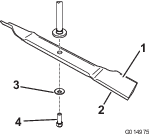
Sharpening the Blades
-
Use a file to sharpen the cutting edge at both ends of the blade (Figure 63). Maintain the original angle. The blade retains its balance if the same amount of material is removed from both cutting edges.

-
Check the balance of the blade by putting it on a blade balancer (Figure 64). If the blade stays in a horizontal position, the blade is balanced and can be used. If the blade is not balanced, file some metal off the end of the sail area only (Figure 64). Repeat this procedure until the blade is balanced.

Installing the Blades
-
Install the blade onto the spindle shaft (Figure 62).
Important: The curved part of the blade must be pointing upward toward the inside of the mower to ensure proper cutting.
-
Hold the blade end using a rag or thickly-padded glove (or place a wrench on the top sheave nut). Install the washer with the cupped side towards the blade and blade bolt.
-
Torque the blade bolt to 60-80 ft-lb (81-108 N-m).
Warning
Incorrect installation of the blade or components used to retain the blade cause the blade to come loose and could seriously injure or kill you or bystanders.
Always install the original Exmark blades, washers and blade bolts as shown.
Leveling the Mower Deck
Check to ensure the mower deck is level any time you install the mower or when you see an uneven cut on your lawn.
The mower deck must be checked for bent blades prior to leveling; any bent blades must be removed and replaced. Refer to the Checking for Bent Blades procedure before continuing.
The mower deck must be leveled side-to-side first then the front to rear slope can be adjusted.
Requirements:
-
The machine must be on a level surface.
-
All four tires must be properly inflated. Refer to Checking the Tire Pressure in the Drive System Maintenance section.
Side-to-Side Leveling
-
Park machine on level ground, move the motion control levers out to engage the parking brake, disengage the blade control switch, stop engine, and remove key and wait for all moving parts to stop before leaving the operating position.
-
Set the height of cut to 3 inches (76 mm).
-
Carefully rotate the blades so that they are all side to side (Figure 65 and Figure 66).
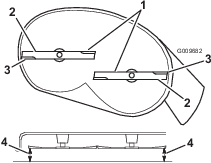
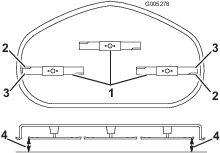
-
Measure between the outside cutting edges and the flat surface (Figure 65 and Figure 66). If both measurements are not within 3/16 inch (5 mm), an adjustment is required; continue with this procedure.
-
Support the weight of mower deck by placing wood blocks under the edges of the deck.
-
Place two blocks, each having a thickness of 2 5/8 inches (6.6 cm), under each side of the front edge of the deck
-
Place two blocks, each having a thickness of 2 7/8 inches (7.3 cm), under the rear edge of the cutting deck skirt, one on each side of the deck.
Note: Avoid placing the supports under any anti-scalp rollers if present on the deck.
-
-
Remove the hairpin cotter and washer from the lower lift-arm pin (Figure 67).

-
Rotate the height of cut plate to a different hole so that it supports the weight of the mower deck after the plate is installed (see Figure 68).
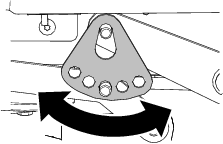
-
Install the washer and hairpin cotter (Figure 68).
-
Repeat steps 6 through 8 for the other side of the machine.
-
Check the side-to-side level again; repeat this procedure until the measurements are correct.
-
Check the side-to-side adjustments again. Repeat this procedure until the measurements are correct.
-
Continue leveling the deck by checking the front-to-rear blade slope; refer to Adjusting the Front-to-Rear Blade Slope section.
Adjusting the Front-to-Rear Blade Slope
Check the front-to-rear blade level any time you install the mower. If the front of the mower is more than 5/16 inch (7.9 mm) lower than the rear of the mower, adjust the blade level using the following instructions:
-
Park machine on level ground, move the motion control levers out to engage the parking brake, disengage the blade control switch, stop engine, and remove key and wait for all moving parts to stop before leaving the operating position.
-
Set the height of cut lever to middle position.
Note: Check and adjust the side-to-side blade level if you have not checked the setting; refer to Side-to-Side Leveling.
-
Carefully rotate the blades so they are facing front to rear (Figure 69 and Figure 70).
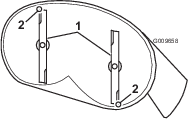
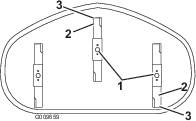
-
Measure from the tip of the front blade to the flat surface and the tip of the rear blade to the flat surface (Figure 69 and Figure 70). If the front blade tip is not 1/16-5/16 inch (1.6-7.9 mm) lower than the rear blade tip, adjust the front locknut.
-
To adjust the front-to-rear blade slope, rotate the adjustment nut in the front of the mower (Figure 71).
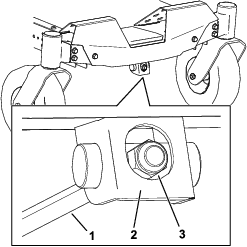
-
To raise the front of the mower, tighten the adjustment nut. To lower the front of the mower, loosen the adjustment nut.
-
After adjustment, check the front-to-rear slope again. Continue adjusting the nut until the front blade tip is 1/16-5/16 inch (1.6-7.9 mm) lower than the rear blade tip (Figure 69 and Figure 70).
-
When the front-to-rear blade slope is correct check the side-to-side level of the mower again; refer to Side-to-Side Leveling.
Removing the Mower Deck
-
Park machine on level ground, move the motion control levers out to engage the parking brake, disengage the blade control switch, stop engine, and remove key and wait for all moving parts to stop before leaving the operating position.
-
Lower the height of cut lever to the lowest position.
-
For 34, 42, and 50 Inch Models
-
Remove the hairpin cotter and washer from the front support rod and remove the rod from the deck bracket (Figure 72). Carefully lower the front of the mower deck to the ground.
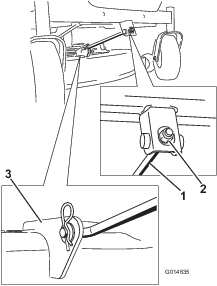
-
On one side of the machine, remove the washer and hairpin cotter from the deck pin .
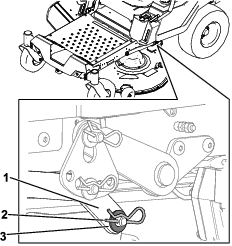
-
Remove the lift arm from the deck pin.
-
Repeat steps 2 and 3 for the other side of the machine.
-
Slide the mower deck rearward to remove the mower belt from the engine pulley.
-
-
For 54 Inch Models
-
At the rear of the mower deck, remove the two shoulder bolts and nuts securing the deck to the pivot pan.
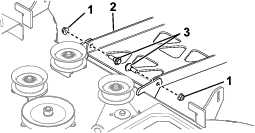
-
At all four corners of the deck, remove the hairpin cotter and washer from the deck pin

-
Raise the height of cut to the highest position.
-
Remove the belt from the clutch pulley on the engine.
-
-
-
Slide the mower deck out from underneath the machine.
Note: Retain all parts for future installation.
Installing the Mower Deck
-
Park machine on level ground, move the motion control levers out to engage the parking brake, disengage the blade control switch, stop engine, and remove key and wait for all moving parts to stop before leaving the operating position.
-
Slide the mower deck under the machine.
-
Lower the height of cut lever to the lowest position.
-
Install the mower belt onto the engine pulley; refer to Replacing the Mower Belt.
-
To install the mower deck:
-
For 34, 42, and 50 Inch Models
-
On one side of the machine, lift the rear of the mower deck and install the lift arm to the deck pin (Figure 73).
-
Install the lift arm using the washer and hairpin cotter.
-
Repeat steps 1 and 2 for the other side of the machine.
-
-
For 54 Inch Models
-
Lift the rear of the mower deck and attach the rear deck hangers to the rear deck pins (reference Figure 75).
-
Attach the front deck hangers to the front deck pins.
-
Secure the deck pins with the hairpin cotters and washers removed previously.
-
Secure the rear of the deck to the pivot pan using the shoulder bolts and nuts removed previously (reference Figure 74).
-
-
-
Level the deck; refer to Leveling the Mower Deck section.
Mower Belt Maintenance
Inspecting the Belts
| Maintenance Service Interval | Maintenance Procedure |
|---|---|
| Every 25 hours |
|
Check the belts for cracks, frayed edges, burn marks, or any other damage. Replace damaged belts.
Replacing the Mower Belt
Squealing when the belt is rotating, blades slipping when cutting grass, frayed belt edges, burn marks, and cracks are signs of a worn mower belt. Replace the mower belt if any of these conditions are evident.
-
Park machine on level ground, move the motion control levers out to engage the parking brake, disengage the blade control switch, stop engine, and remove key and wait for all moving parts to stop before leaving the operating position.
-
Set the height of cut at the lowest cutting position [1 1/2 inch (38 mm)].
-
Remove the hairpin cotter and push in the tab on the cover to remove the pulley covers.
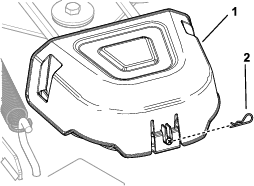
-
Using a spring removal tool, (P/N 92-5771), remove the idler spring from the deck hook to remove tension on the idler pulley and roll the belt off of the pulleys.
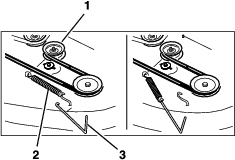
Warning
The spring is under tension when installed and can cause personal injury.
Be careful when removing the belt.
-
Route the new belt around the engine pulley and mower pulleys.
-
Using a spring removal tool, (P/N 92-5771), install the idler spring over the deck hook and placing tension on the idler pulley and mower belt.
Replacing the Discharge Deflector
Danger
An uncovered discharge opening could allow the lawn mower to throw objects in the operator’s or bystander’s direction and result in serious injury. Also, contact with the blade could occur.
Never operate the lawn mower unless you install a mulch plate, discharge deflector, or grass collection system.
Inspect the discharge deflector for damage before each use. Replace any damaged parts before use.
-
For 34 Inch Models
-
Park machine on level ground, move the motion control levers out to engage the parking brake, disengage the blade control switch, stop engine, and remove key and wait for all moving parts to stop before leaving the operating position.
-
Disengage the spring and slide the rod out of the welded deck brackets, spring, and discharge deflector (Figure 78).
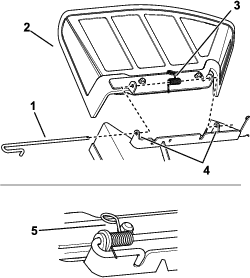
-
Remove the damaged or worn discharge deflector.
-
Position the new discharge deflector with the bracket ends between the welded brackets on the deck and install the rod and spring as shown in Figure 78.
Note: Position the spring on the rod as shown so that the shorter spring end comes from under the rod before the bend and goes over the rod as it returns from the bend.
-
Place the end of the rod in the notch of the bracket (Figure 78).
Important: The discharge deflector must be spring loaded in the down position. Lift the deflector up to test that it snaps to the full down position.
-
-
For 42, 50, and 54 Inch Models:
-
Park machine on level ground, move the motion control levers out to engage the parking brake, disengage the blade control switch, stop engine, and remove key and wait for all moving parts to stop before leaving the operating position.
-
Remove the nut (3/8 inch) from the rod under the mower (Figure 79).
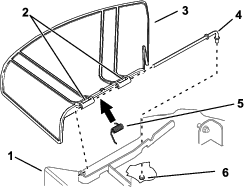
-
Slide the rod out of the short standoff, spring, and discharge deflector.
-
Remove the damaged or worn discharge deflector.
-
Install the new discharge deflector.
-
Slide the straight end of the rod through the rear discharge deflector bracket.
-
Place the spring on the rod, with end wires down, and between the discharge deflector brackets.
-
Slide the rod through the second discharge deflector bracket.
-
Insert the rod at the front of the discharge deflector into the short standoff on the deck.
-
Secure the rear end of the rod into the mower with a nut (3/8 inch) as shown in Figure 79.
Important: The discharge deflector must be spring loaded in the down position. Lift the deflector up to test that it snaps to the full down position.
-
Cleaning
Cleaning and Storing Safety
-
Park machine on level ground, move the motion control levers out to engage the parking brake, disengage drives, stop engine, and remove key. Wait for all moving parts to stop before leaving the operator’s position. Allow the machine to cool before servicing, adjusting, fueling, cleaning, or storing.
-
Clean grass and debris from the cutting unit, muffler, drives, grass catcher, and engine compartment to prevent fires.
-
Allow the machine to cool before storing the machine in any enclosure. Do Not store the machine or fuel container, or refuel, where there is an open flame, spark, or pilot light such as on a water heater or other appliance.
Clean Grass Build-Up Under Deck
| Maintenance Service Interval | Maintenance Procedure |
|---|---|
| Before each use or daily |
|
-
Stop engine, move the motion control levers out to engage the parking brake, wait for all moving parts to stop, and remove key.
-
Raise deck to the transport (4 1/2 inch (114 mm) cutting height) position. Lift the front of machine and support unit using jack stands or equivalent support.
-
Clean out any grass build-up from underside of deck and in discharge deflector.
Clean Debris From Machine
| Maintenance Service Interval | Maintenance Procedure |
|---|---|
| Before each use or daily |
|
-
Stop engine, move the motion control levers out to engage the parking brake, wait for all moving parts to stop, and remove key.
-
Clean off any oil, debris, or grass build-up on the machine and cutting deck, especially under deck belt shields, around the fuel tank, around engine and exhaust area.
Important: You can wash the machine with mild detergent and water. Do not pressure wash the machine. Avoid excessive use of water, especially near the control panel, under the seat, around the engine, hydraulic pumps, and motors.
Clean Engine and Exhaust System Area
| Maintenance Service Interval | Maintenance Procedure |
|---|---|
| Before each use or daily |
|
Caution
Excessive debris around engine cooling air intake and exhaust system area can cause engine, exhaust area, and hydraulic system to overheat which can create a fire hazard.
Clean all debris from engine and exhaust system area.
-
Stop engine, move the motion control levers out to engage the parking brake, wait for all moving parts to stop, and remove key.
-
Clean all debris from rotating engine air intake screen, around engine shrouding, and exhaust system area.
-
Wipe up any excessive grease or oil around the engine and exhaust system area.
Waste Disposal
Motor Oil Disposal
Engine oil and hydraulic oil are both pollutants to the environment. Dispose of used oil at a certified recycling center or according to your state and local regulations.
Battery Disposal
Danger
Battery electrolyte contains sulfuric acid, which is poisonous and can cause severe burns. Swallowing electrolyte can be fatal or if it touches skin can cause severe burns.
-
Wear safety glasses to shield eyes, and rubber gloves to protect skin and clothing when handling electrolyte.
-
Do Not swallow electrolyte.
-
In the event of an accident, flush with water and call a doctor immediately.
Federal law states that batteries should not be placed in the garbage. Management and disposal practices must be within relevant federal, state, or local laws.
If a battery is being replaced or if the unit containing the battery is no longer operating and is being scrapped, take the battery to a local certified recycling center. If no local recycling is available return the battery to any certified battery reseller.
Troubleshooting
Important: It is essential that all operator safety mechanisms be connected and in proper operating condition prior to mower use.
When a problem occurs, Do Not overlook the simple causes. For example: starting problems could be caused by an empty fuel tank.
The following table lists some of the common causes of trouble. Do Not attempt to service or replace major items or any items that call for special timing of adjustments procedures (such as valves, governor, etc.). Have this work done by your Engine Service Dealer.
Note: When disconnecting electrical connectors Do Not pull on the wires to separate the connectors.
| Problem | Possible Cause | Corrective Action |
|---|---|---|
| The engine overheats. |
|
|
| The starter does not crank |
|
|
| Engine will not start, starts hard, or fails to keep running |
|
|
| Engine loses power |
|
|
| The machine does not drive. |
|
|
| Abnormal vibration |
|
|
| Uneven cutting height. |
|
|
| Blades do not rotate. |
|
|
Schematics
Electrical Logic Schematic
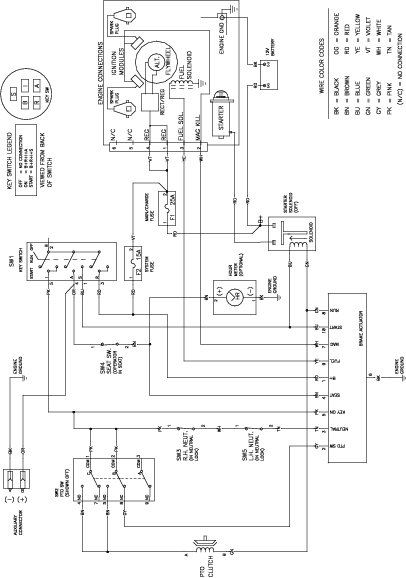
Slope Indicator
